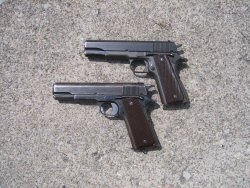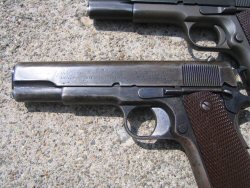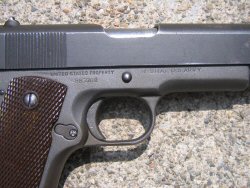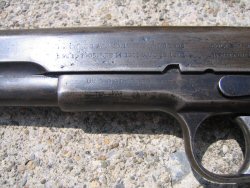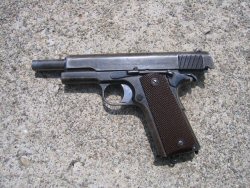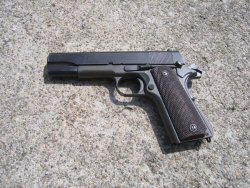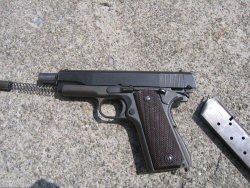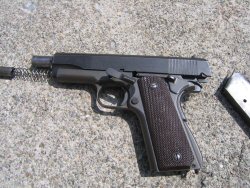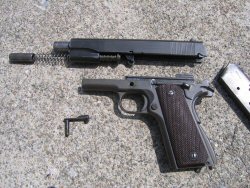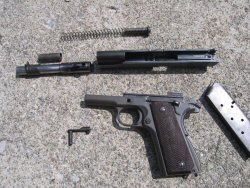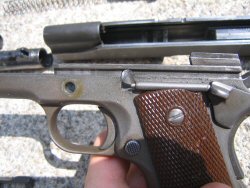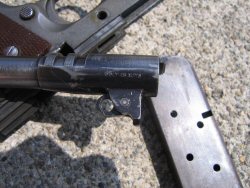What To Look For When Purchasing An M1911 Pistol
Date Written: Aug 2008
Author: Chris Guska
Introduction:
I often get asked: What do you look for when you buy a 1911? How do I know if it's in good mechanical shape? How do I know I'm not getting taken?
Well - I'll walk you through a series of things to check for when evaluating a 1911 series pistol for purchase. Many of these things are universal and apply to all pistol purchases - but some are specific to the 1911 for the reenactor.
Before you leave the house:
1.) Know what you are looking for. Do some research and know at least the very basics.
2.) Set your budget and get that amount of cash on hand. Cash is key! Everybody accepts it, not everybody accepts plastic, hardly anybody wants your personal check, and promises aren’t worth shit.
3.) Know what you want. Are you looking for a collector’s piece, a shooter grade original, a modern production look alike, or just any old blaster for busting blanks?
Don’t buy the story
Lots of sellers will try and sell you on a story - or accessories, like having the "original" kraft paper box for the 1911, or it being with a holster rig "from the vet".
Don't buy the story. There are reproduction boxes and any idiot can buy a holster rig on eBay.
Be Objective! LOOK at the gun and have a clear mind.
Look before you touch:
Before you start finger fornicating your potential new 1911, CALM DOWN. I can’t stress this enough, as it is the #1 way of getting utterly hosed. CALM DOWN! Be zen like, breathe deep, put your emotions aside and be objective. No matter what the price, good, bad or ugly - a bad, broken, modified, bubbafied pistol is not something you want to deal with. If you have the knowhow, skills, tools and expertise to deal with a bad, broken, modified or bubbafied pistol - stop reading this article as it's what you already know.
I've seen it with other people, I've done it myself: Going up to the table, seeing a USGI 1911 with a too good to be true price on it and both hands reaching back to reach for the wallet, fumble the wallet on the floor, pick it up, rip the money out of the wallet and throw it at the seller to get it without so much as a basic function check.
If you're able to get past that step, the next to overcome is the token once over of the gun while your hands tremble in excitement over your great find....
Once again, put the emotions aside, be calm and do as follows:
Evaluating the 1911:
Overall ConditionWhat is the overall condition of the pistol? Does it have a good strong finish on it? Does it look like it has been reblued? Does the lettering on the gun look strange at all? Smeared? Faded? Rubbed out? Does the gun have US Property markings on it? Does the gun have a legible serial number?
An example of worn / faded lettering.WW1 US Property Markings - Left side, front of frame. WW2 US Property Markings - Right side, above trigger. Does the gun have any cracks, gouges, scrapes or metal missing? Areas to check for on 1911's are
Cracked front of slideRear of slide
Ejection Port Front of frame and slide stop notch Function / Safety Check
Pull the slide back - does it come back smoothly or does it grate? Does the slide lock back when a magazine is inserted?Remove the magazine with the slide locked back, the magazine should drop free or be removed very easily, release the slide stop so that the slide returns to "in battery" position. Repeat this two or three times - as it does not always manifest itself the first try. The hammer should stay cocked. If the hammer does not stay cocked, dropping to half cock or fully down, the gun will need new parts and repair work. This does not disqualify the gun entirely as it can be fixed, but will provide you with bargaining room on the price.
If the magazines are difficult to remove or insert into the frame, this is a good indication that the gun has been messed with, or the mags are really bad. In some instances, the frame of the pistol has been "squeezed" over the magwell and trigger area to "tighten up" the trigger on "match guns". Make sure to test the gun with USGI production magazines whenever possible.
Rack the slide so that the hammer is at full cock. Try and engage the thumb safety. It should move without excessive resistance to a positive up or down position with a click.Pull the trigger with the safety in the up position - the hammer should not drop. Set the safety to the down position, pull the trigger, the hammer should drop.
Rack the slide again so that the hammer is at full cock, leave the safety in the down position. Grip the gun by the slide - not by the pistol grip so you are not holding down the grip safety. Try and pull the trigger without the grip safety being depressed - the hammer should not fall. Grip the 1911 normally and pull the trigger - the hammer should fall.
Once again cock the hammer and grip the 1911 normally. Pull the slide back about 1/4 inch and try and pull the trigger - the hammer should not fall. Slowly let the slide forward and stop about a penny's thickness from closing all the way (1/8 inch) and pull the trigger again, the hammer should not fall. The hammer should fall only when the slide is nearly or completely closed. If the hammer falls when the slide is not totally closed, the disconnector needs to be replaced before the pistol can be fired.
With the slide forward, in battery position, grip the pistol normally and with your other hand grip the slide. Attempt to wiggle the side left to right to see if the slide to frame fit is sloppy. There should be some minor movement, but if there is significant play, to the point where if you give the gun a shake the slide rattles significantly - you may want to pass or have additional negotiations.
Disassembly
If the 1911 has passed muster so far, now it's the time to ask the seller if you can take the slide off the frame. That is only as far as you should disassemble the 1911 for evaluation. If the seller does not let you do so, even after showing him that you have the money and are serious - walk away as they're trying to hide something.
Disassembly Step 1:
Point the piece in a safe direction, remove the magazine, double check that the chamber is clear and the piece is unloaded.
Disassembly Step 2:
Depress the recoil spring cap and rotate the barrel bushing towards the left hand side of the slide.Disassembly Step 3:
Pull the slide back so that the small notch in the slide is directly over the slide stop endFrom the right side of the pistol, push the slide stop out towards the left, freeing it and removing it from the frame - set aside. Disassembly Step 4:
Push the slide forward off the frame rails. You have now taken the 45 down to its component groups.Remove the recoil spring cap from the recoil spring, and remove the recoil spring and plunger by pulling them towards the rear of the slide.
Flip the barrel link down so that is resting against the barrel and remove the barrel through the front of the slide. The Barrel bushing should be still facing the left side of the frame so that it is free and not locked into the frame.This is only as far as you should disassemble the 45 at a show to inspect for condition.
Check the side and frame rails for any cracks, checks, unusual scarring or wear. Check the frame rails for bulging and to make sure they are absolutely straight.Check the disconnector for wear and any cracks or chips. Make sure that the slide and frame are free of any metal shavings or residue.
Also check to ensure that the mag well sides are parallel, as some guns have been "tightened" in this area by crushing the frame for a better trigger fit.Check the slide, barrel and frame for proof marks and overall condition.
Barrel Markings from the 1943 ColtInspector and Proof markings on the 1943 Colt Slide inscription on the 1943 Colt DON'T be overly concerned with the bore. I've seen SO many people pick up a gun, immediately look at the bore and set it back on the table because it was "frosted" or very slightly pitted. Bore condition should not take precedent over overall gun condition. Barrels are relatively cheap - a brand new barrel can be purchased from Sarco for $20.00 if you really want something to shoot. If you are looking for match accuracy, stop reading this article and look at new guns.
What should a USGI Gun look like
There are numerous websites and books in print that do a fantastic job detailing all the variants of the USGI 1911 - notably:
For Parts, Model and Serial Identification:
www.coolgunsite.com
www.sightm1911.com
For finishes and general info:
http://www.restoration-gunsmith.com/
The Reference Books:
Craig Reich’s' The Model 1911 and Model 1911A1 Military and Commercial Pistols
Charles Clawson's Collector's Guide to Colt .45 Service Pistols: Models of 1911 and 1911a1
I highly recommend purchasing one of the books, if not spending considerable time researching before you make any purchases.
Conclusion
Slow down, Calm down and take your time when evaluating any potential 1911 purchase. Do your homework ahead of time, set your budget and set your expectations.
If you take your time, understand how the gun functions and what you're going to do with it and it will be much easier to get a good condition gun that will not need further financial investment to safely operate.
Remember that 1911 parts are available and fairly easy to replace. A gun that has had parts swapped or minor issues can be fixed with some time, work and money. Know what is correct and what it may cost to get your new 1911 to a safe and correct condition. Having the knowledge and knowing what you want will give you the latitude to negotiate intelligently and get a better deal.
This is not the be all, end all guide to 1911's. It is simply an introductory guide to evaluating them so you don’t get in over your head on your first purchase. Chances are, once you get one - you'll get the bug and learn all there is to know about 1911's.
As always, be patient. Deals often take years to pop up and when they do they sure are sweet. Have the patience and restraint to wait for the 1911 that fits your budget and expectations - you'll be much happier in the long run.
90th IDPG Articles



